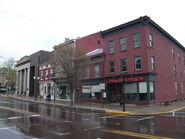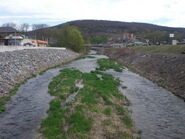|
Danville is the third largest community in Susquehanna, with an area of 1.6 square miles. It is the county seat of Montour County, and is an important industrial and medical hub for the nation as a whole.
Pre-Doomsday
The land that now makes up Danville was owned by the Iroquois tribe, who sold it to William Montgomery in 1774. He established a small trading post named Montgomery's Landing, and in 1792 he constructed a small house, which still stands today. Danville was part of Northumberland County when it was founded, and became the county seat of Columbia County in 1813 until 1845 when, after an election, the seat was moved to Bloomsburg. This caused a dispute between Bloomsburg and Danville, leading to the formation of Montour County, named after an Iroquois woman, Madame Montour. Danville was named the county seat.
In the 19th century, Danville grew in importance with several rail line and canals running into, and through the community. The discovery of iron deposits led to an industrial boom, manufacturing T-rails for railroads, claiming to be the first to roll one, occurring on October 8, 1845 at the Montour Iron Company. This was disputed by Mount Savage, Maryland, and the two communities shared a friendly rivalry.
But the iron mills began to lose their importance with the introduction of steel in the 20th century, with the last one closing in the late 1960's. The former iron mills were replaced by a State Hospital, middle school, and other buildings. Other companies would gain steam, with Geisinger Hospital (Modern day Geisinger Medical Center) opening in 1915, a TRW facility, as well as machine shops and pharmaceutical facility across the river.
But on Doomsday it all would come screeching to a halt.
Doomsday
The borough was spared on Doomsday, and had no effect from the blasts other than the loss of power and other electronics from the EMP. The unfortunate problem was, like most communities around the United States, it descended into chaos. Many fled west, and by the time the Bloomsburg was stable enough to survive, the population was approximately 3000 people.
Citizens who remained tell that they felt the ground shake from the nuclear blasts. Some on the north side saw mushroom clouds form over the mountains from Wilkes Barre and Scranton. The survivors feared a strike on the nuclear power plant.
That strike either was never ordered, missed, or was not launched.
Post Doomsday
Immediately after the blasts, the borough collapsed. Panicking people ransacked all the stores, police stations, and other buildings for food, fuel and weapons. Most fled but the survivors managed to form a bastion at Geisinger Medical Center. They fortified the area around it, and using sparse fuel supplies, and scavenged materials, managed to keep things running at the complex.
After Bloomsburg managed to save the community, the area was re-organized and rebuilt. The dike system built around the community was reinforced and used as defense.
Slowly over time, through scrounging, resourcefulness, and luck, the area sprang back to become a major manufacturing hub in the nation. The former State Hospital was modified to serve as the iron and steel mills. It also serves as a jump point to State College, with rail lines, roads, and interstate lines connecting the two countries.
Modern Day
Today, Danville is the third largest city in Susquehanna. It has most of the nation's manufacturing center, although recently the industry has gotten more diverse into other cities.
The community has since recovered from the pre-Doomsday collapse, and has a thriving downtown. They also maintain a decent sized police force to keep the law and order.
Susquehanna operates a small unit of support and logistical troops in the nation. There are no combat soldiers due to the stability at the border.
Demographics
The borough lost over half of the pre-Doomsday population due to disease and refugees fleeing. The majority of people in the borough are whites of European descent, although there is a handful of blacks and Asians in the community. It has a population of 2,311 people as of the 2015 census.
Infrastructure
The infrastructure in Danville is fairly modern, with railroad tracks linking it to the rest of the nation, and roads that have been kept in fairly good shape. There is no public transit in the borough, although there is a fairly high car ownership rate in the community, with over 20 privately owned cars operating, and five government owned vehicles.
Downtown
Downtown Danville is the primary commercial hub of the county. There are many small mom and pop shops located here selling things from food, to clothes, to secondhand items, and trinkets.
Transportation
Danville does not offer public transportation, although due to the small size, it is unneeded. Most citizens own bikes, or a horse and buggy. Bloomsburg does run a bus line into the borough. Many use it to go shopping in the capital, or to switch lines, going to the 'city' of Hazleton.
A single van is operated for the elderly who are unable to take care of themselves. The borough also has an ambulance service for emergencies.
The nearest public airport within Susquehanna is Hazleton International Airport in Hazleton, Wyoming County. This airport serves most of the nation, although some drive to State College to fly out.
Law Enforcement
Danville has an eight-officer police department. They are all full time, and many are ex-military. Their main job is to prevent crime and keep them imprisoned.
Economy
There are several companies that operate out of Danville. Geisinger Medical Center, the third largest employer in the nation, employs several thousand people in the community and the county. Weis Markets operates a single store in the borough, which provides thirty two people with jobs.
Danville Area School district provides some jobs for a few months out of the year. Many teachers hold down other jobs in industries that pick up during the summer to make enough money.
Danville hosts the lifeblood of Susquhanna's manufacturing and industry, with many different companies having factories located there. The Danville Steel Mills, Montour Concrete Manufacturer's, and Cabinet Industries all have facilities in or near the borough.
Per capita GDP is slightly lower than the national average due to the unskilled labor force. It is around $600 USD
Education
Danville is covered by Danville Area School District, having students from pre-K to 12. It is one of the better educated communities in the nation, with a literacy rate of approximately 70%, compared to the national average of 47%. There are no colleges or universities in the county, with the nearest one being Bloomsburg University, in Bloomsburg.
Nicknames
Danville didn't have any official nicknames prior to Doomsday. After the nuclear war and the reconstruction of the town, it received a few new ones. Most related to its primary economic base, coal, iron, and steel.
- Post Doomsday
- Coal Town, CoS
- Ironville
- Steel City
Future
The borough, along with Bloomsburg, are the most rapidly growing communities in Susquehanna. Infrastructure is kept up to date so if there is an influx of people, the borough can support them. There are no new planned buildings for the community, with upkeep being expensive enough. Coal will continue to be mined in the town as well as iron, so that will be continued income. Geisinger is expanding to support the demand, and is expected to bring new jobs.





